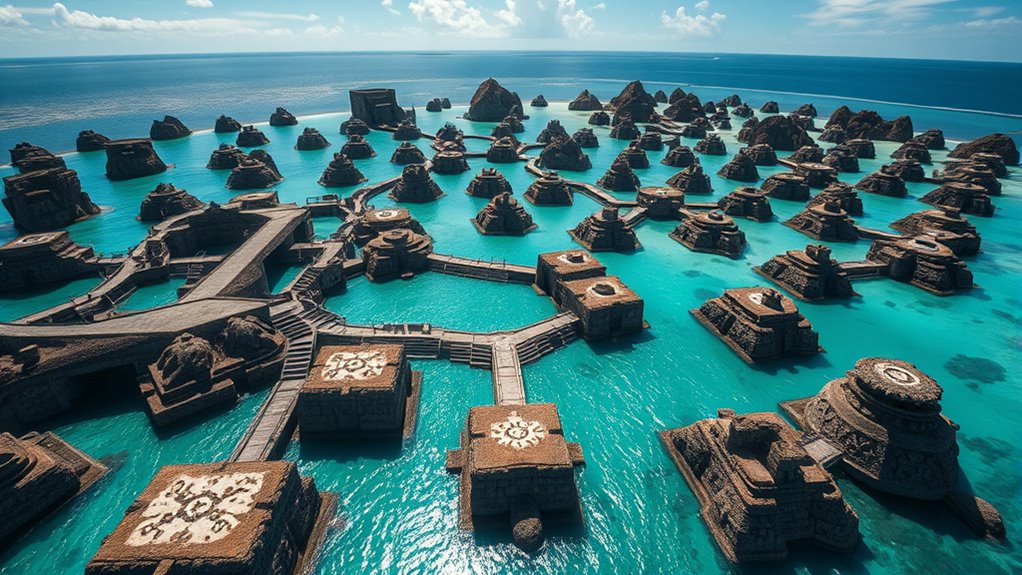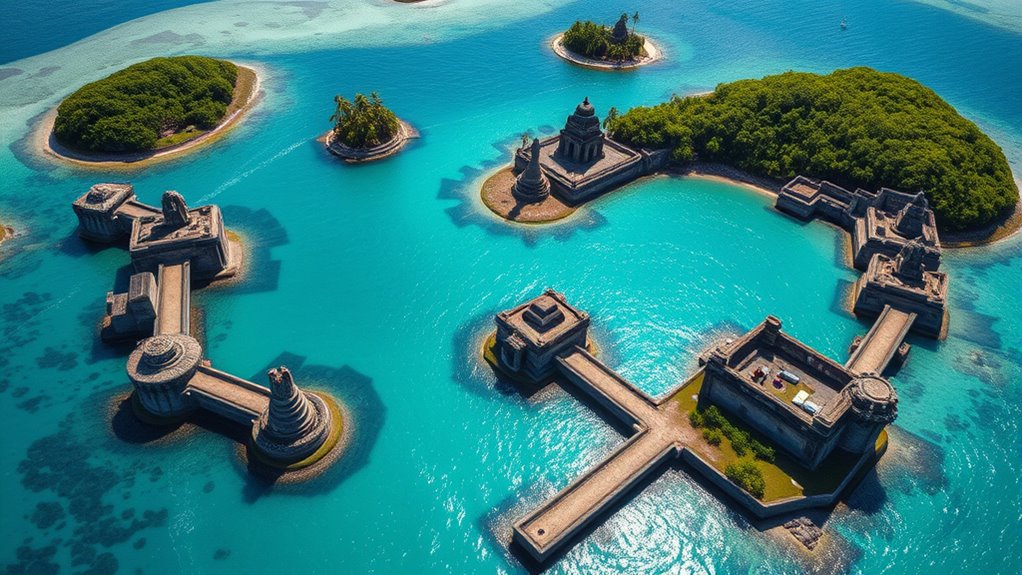Nan Madol, called the “Venice of the Pacific,” is an incredible archaeological site built on a network of coral stone islets off Pohnpei in Micronesia. You’ll see an intricate maze of stone walls and channels, showcasing advanced engineering skills of its creators around 1500 CE. The site served as a political and ceremonial hub, reflecting ancient cultural practices. If you explore further, you’ll uncover fascinating secrets behind this mysterious, surreal landscape and its rich history.
Key Takeaways
- Nan Madol is an ancient city built on coral stone islets off Pohnpei, Micronesia, earning the nickname “Venice of the Pacific.”
- Its intricate network of coral stone walls and channels creates a surreal, labyrinthine landscape.
- Constructed around 1500 CE, it served as a political and ceremonial center for the Saudeleur Dynasty.
- The site features large basalt and coral stones, showcasing advanced engineering skills of its creators.
- Responsible tourism and preservation efforts are essential to protect this archaeological and cultural landmark.

Nestled off the coast of Pohnpei in Micronesia, Nan Madol earns its nickname as the “Venice of the Pacific” thanks to its intricate network of ancient coral stone islets. As you explore this mysterious site, you’ll notice how the massive stone walls and channels create a labyrinthine landscape that seems almost unreal. This ancient city, built entirely on coral platforms, holds profound archaeological significance, offering insights into the social and political life of its creators. When visiting, it’s important to consider sustainable tourism practices that preserve its delicate structures and natural surroundings. Responsible behavior ensures future generations can also marvel at its marvels, keeping the site’s integrity intact while promoting local communities’ well-being.
Discover Nan Madol’s labyrinth of coral islets—an archaeological marvel demanding respectful, sustainable exploration to preserve its timeless beauty.
Nan Madol’s archaeological significance cannot be overstated. It’s believed to have served as a political and ceremonial hub for centuries, dating back to around 1500 CE. The complex’s construction with large basalt and coral stones, some weighing several tons, showcases advanced engineering skills for its time. As you walk among the remains, you become a part of a living history that continues to puzzle archaeologists. The site’s purpose remains partly shrouded in mystery, fueling ongoing research and fascination. Its significance extends beyond its impressive architecture; it embodies the cultural identity and spiritual practices of the Saudeleur Dynasty, the ancient rulers of Pohnpei. Understanding and respecting this archaeological heritage helps foster awareness and appreciation for indigenous history and traditions.
While exploring Nan Madol, you’re encouraged to adopt sustainable tourism practices. Stick to designated paths, avoid touching or removing stones, and refrain from graffiti or vandalism. These simple actions help prevent erosion and damage caused by foot traffic. Supporting local guides and artisans also promotes economic sustainability within the community. By doing so, you contribute to preserving the site’s authenticity and ensuring it remains a source of cultural pride and educational value. Nan Madol’s fragile coral platforms are particularly susceptible to environmental impacts, such as rising sea levels and climate change, making your mindful tourism all the more crucial. Additionally, understanding the engineering techniques used in its construction can deepen your appreciation of the site’s historical significance.
In essence, your visit to Nan Madol offers a unique window into Micronesia’s rich history while emphasizing the importance of safeguarding this archaeological treasure. Respect for the site and its cultural significance ensures that future visitors will also be able to experience its mystique. Embracing sustainable tourism not only enhances your understanding but helps maintain the delicate balance between human curiosity and environmental preservation. Through responsible engagement, you help protect Nan Madol’s extraordinary legacy, allowing it to continue inspiring awe for generations to come.
Frequently Asked Questions
What Is the Estimated Age of Nan Madol?
You might wonder about the age of Nan Madol. It’s believed to be around 1,000 years old, dating back to approximately the 13th or 14th century. The site’s geological formation involves coral reef and volcanic stone, which locals used for construction. You can see how ancient construction techniques, like stacking coral blocks, created impressive platforms and structures that have withstood centuries, showcasing their remarkable engineering.
How Were the Massive Coral Stones Transported and Assembled?
Did you know that some coral stones at Nan Madol weigh over 50 tons? You’d find that coral transportation was a monumental challenge. Workers likely used logs as rollers and rafts to move these massive stones across the reef. For construction techniques, they probably employed clever stacking and fitting methods, with minimal mortar, to assemble the stones into impressive structures. It’s a demonstration of their ingenuity and engineering skills.
Are There Any Ongoing Archaeological Excavations at Nan Madol?
You might wonder if there are ongoing excavation updates at Nan Madol. Currently, archaeologists continue to explore this mysterious site, leading to new archaeological discoveries and insights. These excavations help uncover more about its construction and history. As work progresses, you can stay informed through updates from researchers and institutions involved, ensuring you’re aware of the latest findings and how they deepen our understanding of this incredible ancient city.
What Cultural Significance Does Nan Madol Hold for Local Communities?
Imagine walking through a place steeped in mystery, where traditional ceremonies echo through the air and local legends whisper of ancient powers. This is how Nan Madol holds deep cultural significance for local communities. It’s more than ruins; it’s a sacred site where traditions are kept alive, and stories of ancestors are passed down. You can feel the spirit of the past intertwined with present-day life, making it a cherished cultural treasure.
Can Visitors Access the Interior of the Ancient Structures?
You might wonder if you can explore the interior of Nan Madol’s ancient structures. Tourist access is limited to preserve the site, so interior exploration isn’t generally allowed. Visitors can admire the impressive stone ruins from a distance, but entering the structures is restricted to protect their integrity. Respect the rules to help preserve this UNESCO World Heritage site, ensuring future generations can also experience its historical significance.
Conclusion
You stand in awe of Nan Madol’s breathtaking beauty, marveling at its ancient ingenuity, its intricate coral platforms, and its mysterious history. You feel the wonder of a city built on coral, the strength of its stones and the stories they hold. You sense the connection between past and present, between nature and human craft. You realize that Nan Madol isn’t just a marvel of architecture, but a tribute to resilience, ingenuity, and the enduring spirit of its creators.










